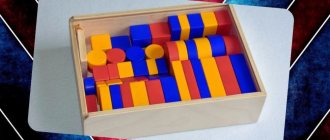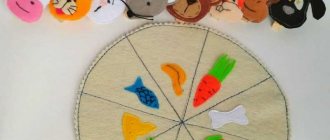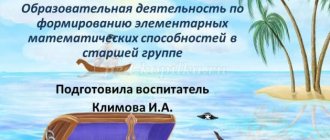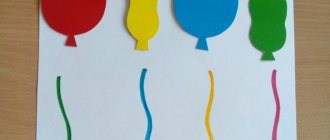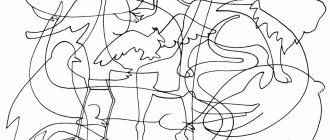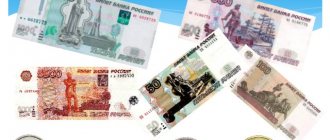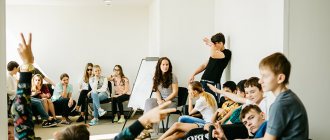Tatyana Golyakova
Card index of games for the formation of concepts about the size of objects for preschoolers 4–5 years old
MAOU Secondary School No. 1 structural unit "Kindergarten"
.
City of Tobolsk, Tyumen region.
«CARD INDEX OF GAMES
FOR FORMING CONCEPTS ABOUT THE SIZE OF OBJECTS
CHILDREN ARE 4-5 YEARS OLD .”
Educator:
Golyakova T. A.
Tobolsk, 2018
"Hide and Seek"
Goal: practical acquaintance with the quantity .
Material: cubes, marbles, balls and any other objects of large and small size.
Progress of the game: Cubes, marbles, balls and any other objects of large and small size are laid out in front of the child. The adult asks the child to hide a small ball in his palm , the ball is not visible; then another small object is hidden in the palm , the game “Peek-a-boo”
.
Next, we give him a large ball and also ask him to hide it, but it doesn’t work. We conclude that small objects can be hidden in the palms , but large ones cannot.
"Builders"
Option 1. Goal: sort items by size .
Material: toy car, large and small cubes (you can take Lego parts)
).
How to play: We bring large and small cubes by car.
— "Transforming"
We became builders and built tower houses: one house for a bear from large cubes, and another for a bunny from small cubes.
It is advisable to beat the “bear”
and
“hare”
with the help of a poem:
“The bear has a big house (we spread our hands,
And the hare is small (put your palms )
.
Our bear went home (we depict the gait of a bear,
And behind him comes the bunny (jumping)
».
Option 2. Purpose: to consolidate knowledge about the size of objects , to introduce the concepts of “tall”
,
“low”
,
“equal in height”
.
Material: toy car, cubes of the same size.
Summary of GCD on FEMP for preschoolers 4-5 years old
Abstract of GCD for FEMP
Program tasks: Quantity and counting: establishing a correspondence between the number and quantity of objects. Size: large, smaller, smallest. Geometric shapes: square, circle, triangle (find among many shapes). Time orientation: seasons (autumn), parts of the day. Orientation on a sheet of paper: left, right. Purpose: • To learn to compare two groups of objects, to establish equality between them; • Learn to add the missing item to a smaller group; • Learn to navigate on a sheet of paper (left, right); • Learn to understand the learning task and complete it independently; • Continue to teach how to compare objects by size (large, smaller, smallest); • Keep the score within five. • Consolidate knowledge about geometric shapes: circle, triangle, square; • Foster activity, independence, goodwill, and a desire to help each other. Visual material and equipment: Demonstration material: flannelgraph, magnetic board, 5 cards with images of bears, five cards with images of barrels. Handout: cards divided by a vertical strip into left and right sides; pictures of squirrels and mushrooms for each child; cards depicting geometric shapes according to the number of children; a tray with geometric shapes (circles, squares and triangles) for each child; rudder cards according to the number of children. PROGRESS OF NODE 1.Work with demonstration material. Guys, listen to the poem. “If the leaves on the trees have turned yellow, If the Birds have flown to a distant land, If the sky is frowning, If the rain is pouring, - This is the time of year... -Who can say what it’s called? (children's answer) - That's right. It's called autumn. - And in the fall, all people and animals stock up on food for the winter. Let's help the bears calculate whether there is enough honey for everyone. (Work on flannelgraph: Bear - dad, bear - mom and cubs.) Papa bear, what size? (big); What size is the bear? (slightly less); What about the bear cubs? (the smallest) How many bear cubs? (three) How many bears are there in total? (five) How many barrels of honey? (four) Are there enough kegs for everyone? How much is missing? (one) (the willing child lays out a barrel) What can you say about the number of bears and barrels? (answer: there are equal numbers of them or there are as many barrels as there are bears). You are so great! We need to rest. Physical school The bear cubs lived in the thicket, twisting their heads like this, like this, like this, like this. The cubs were looking for honey, together they rocked the tree. Like this, like this, like this, like this. And then they danced, raising their paws higher. Like this, like this, like this, like this. 2. Work with handouts. Riddle: From branch to branch She flies easily. No one will catch you by your red tail. She has no time to play in the woods in the summer - She needs to collect mushrooms for the winter. (squirrel) - Guys, let's help the squirrels make supplies for the winter. Four girlfriend squirrels went to look for mushrooms, put four squirrels on the card on the left side of the strip. They found three mushrooms, put three mushrooms on the right side. Tell me, how much protein did you put in? Which side? How many mushrooms did you put in? Which side? Is there enough mushrooms for everyone? Why? How many more mushrooms can you find? (one) Find and place the mushroom on the right side. A friend and another squirrel galloped up to the squirrels. How many squirrels are there? (five) How many mushrooms? How many more mushrooms do you need to find? (one) Find and put the mushroom? Which side do you put the mushroom on? (right) What can you say about the number of squirrels and mushrooms? (answer: there are equal numbers of them or there are as many proteins as there are mushrooms). You are so great! They helped everyone make supplies for the winter. Now let's help people take the harvest from their gardens to the garage. D/game “Put the car in the garage” Each child has a steering wheel card, with a different number of circles in the center of the steering wheel (up to five). In different places in the room, garages are indicated by cards with different numbers of circles. Children drive around the room; on command, cars drive away to their garages. Game “Find and Fill” - Guys, let's see how many vegetables we brought to the garage. You have cards with geometric shapes on your table, and geometric shapes on your tray. Find and fill as many circles as there are cucumbers on my table (one) Find and fill as many triangles as there are carrots on my table (two) Find and fill as many squares as there are tomatoes on my table (two) Check friend friend, whether the task was completed correctly, help if your friend is at a loss. Well done guys, did a good job. Thank you all, well done, Everyone counted from the heart, Rest, kids. Methodical manual for the D/game “Put the car in the garage”
We recommend watching:
Summary of a comprehensive lesson on FEMP with elements of application in the middle group. Summary of a lesson in mathematics in the middle group of kindergarten. Synopsis of a game-based cognitive lesson on FEMP in the middle group. Synopsis of joint activities on mathematical development for children of the middle group.
Similar articles:
Math lesson “Rectangle” in the middle group of kindergarten
Mathematics lesson “Ordinal counting” in the middle group
How to play: We bring cubes of the same size by car.
An adult builds two towers of equal height and tells the child that the towers are the same. Then he removes or adds details and tells again,
that now the towers are different, one high, like dad (like a tree, like a lamppost, and the other low, like a son (like a daughter, like a flower)
.
Important: make a visual comparison of the height of objects .
Encourage children to build low, high and identical towers.
"Let's feed the dolls"
Goal: learn to sort objects by size .
Material: large and small dolls, walnuts and hazelnuts.
Prepare large and small dolls, walnuts and hazelnuts in advance. Important: toys must be three-dimensional, flat pictures are not suitable .
Progress of the game: An adult reads a poem:
“A doll is sitting on a cart, selling nuts.”
and takes out a large doll.
- Look, a doll came to us and brought nuts. While the child is looking at the nuts, a small doll appears.
The adult encourages the child to compare the dolls by size and then divide the nuts: the large doll gets large walnuts, and the small doll gets small hazelnuts. Next, you can count the nuts and roll them with your palms to develop fine motor skills.
"Water in glasses"
Purpose: to form the concept of maintaining the volume of liquid in glasses.
Material: two glasses of the same shape , one glass is taller and narrower than the first two.
Progress of the game. Two glasses of the same shape , located at different distances from the child, but with equal amounts of water (which the child did not know about)
.Questions for children:
-What do you see on the table?
- Look and tell me where there is more water?
Children often get confused because the glasses are at different distances from the child and therefore it seems that the amount of water in the glasses is different.
The teacher pours water from one glass into another glass of a different size (in front of the child)
.
During the lesson, the teacher forms in the child the concept that the volume of liquid in glasses will not change regardless of the shape of the glass . Questions for the child:
- Look and tell me where there is more water?
- Tell me, is it equal water?
- Yes, equally. You didn’t pour the water out, but simply poured it into this glass. It is taller and narrower, and it seems that there is more water in it.
"Christmas trees"
Goal: to develop the ability to compare two objects using a third .
Materials: two Christmas trees glued to a sheet, pencil, scissors, measure - a strip of colored paper.
Progress of the game:
In front of the child are two bricks of equal length, located exactly one below the other.
— How to find out which brick is longer?
- You need to measure them (measures the first brick)
.
— Merochka tried it on 2 times. The yardstick will also measure this brick 2 times, because they are the same. (Then I move one of the bricks to the side)
.
The teacher is faced with the task of making children understand that no matter how far objects are from each other, their length does not change. If the child finds it difficult to answer, then you can invite him to mark each measurement on the work card using a counter .
- Now which brick is longer?
- This and this brick are the same, because the measurement showed that
this brick and this brick are the same in length.
“How Grandma and Grandpa Got Lost in the Forest”
Goal: to form the concept of maintaining distance between objects .
Material: two fairy-tale characters, counting sticks, toy tree.
Progress of the game: On the table, at some distance from each other, there are two fairy-tale characters - grandmother and grandfather. The teacher asks the child a question:
- How far do you think grandparents are from each other?
— Is it possible to measure this distance?
- How will you do it?
The child measures the distance with a yardstick or stick.
— There are four measurements between grandparents.
— One day a tree grew between them (I put a tree between the characters)
.
- Do you think grandparents are just as far apart from each other? If the child finds it difficult to answer, then you can invite him to measure the distance between the characters again.
- Yes, the same. I measured without wood, there were four measurements and now there are four measurements. We did not move or move grandparents. Thus, the child better understands that the distance remains, even if there is an object .
“Where is more?”
Goal: to form the concept of maintaining inequality in the amount of a substance, regardless of the shape of the vessel .
Material: two glass glasses of the same shape , in which unequal amounts of water are poured, one narrow glass.
Progress of the game: On the table are two glass glasses of the same shape , in which unequal amounts of water are poured.
We invite the child to take any of the cups (we take the second one for ourselves)
.
- Who do you think has more water, you or me?
- I have more, and you have less.
I pour water from my glass into a narrow glass. The water level becomes higher than in the child's glass, although the volume of water is less.
- Who has more water now?
- I have. Your glass is thin and large and the water has risen. - I have more water. - Why do you think you have more water?
If the child finds it difficult, offer to pour the water into the glass where it was. In this case, the child will see that inequality
amount of water preserved, regardless of the shape of the vessel .
- I understand , you need to pour your water, where it was and then it will be clear
that I have more water.
“Where is the tea?”
Goal: to form the concept of preserving the whole when dividing it into parts.
Material: six cups, four are filled with water, and two cups are empty. Work card , two types of chips.
How to play: There are cups on the table with water in them, and some cups are empty.
- Tell me how many cups are there in total?
- There are six cups in total.
- What is more: just cups or cups of water?
— More cups of water.
“Listen again to what I’m asking you.”
- What are the most cups or cups of water? During this period of learning, children face some difficulties and some children (to the question: what are more: just cups or cups of water)
give the wrong answer.
If the child finds it difficult, then you should invite him to put marks on the work map .
After which the child counts, compares the marks and answers the question posed by the teacher. — Put as many marks on the first row of the card as there are all the cups. — On the second row of the map , put as many marks as there are cups of water.
- Where are there more marks - at the top or at the bottom?
— Top marks, what are they telling you?
- About cups, about all cups.
— Are there marks on the bottom row that remind you of what they’re talking about?
— About cups of water.
- What more?
- All the cups, but fewer cups of water.
"Heavy, light"
Goal: to develop the ability to compare two objects : heavy, light.
Material: 2 small bags. One contains wooden figures: a ball, a cube and a cylinder, the other contains 3 soft toys.
Progress of the game: children stand in a circle, the teacher invites the children to “ride the train”
.
- Turn behind each other, let's go.
The train is here, here,
Train friend - friend
In the morning guys
Takes him to kindergarten.
Children with a teacher “follow each other and see 2 bags. One contains wooden figures: a ball, a cube and a cylinder, the other contains 3 soft toys.
- Stop! There are some bags lying around. (Children lift the bags.)
— One bag is heavy, the other is light.
- Which bag should we open? (Children open the heavy bag, then the light one.)
- Pick up one toy first, then the other. Which one is easier?
— Are the toys the same weight? (Children express their assumptions , the teacher leads them to the fact that the toys are different in weight.)
- Place heavy toys on the right shelf, and light ones on the left.
"Let's water the flower"
Purpose of the game: to give an idea of the invariability of the volume of liquid depending on the shape and size of the vessel .
Material: 2 transparent jars of different shapes and sizes with water , 2 jars of the same shape and size .
How to play: There are 2 cans of different shapes and sizes . In them
the same amount of water, but the children think there is more water in one jar.
— We have 2 cans of water. Let's water the big flower, it needs a lot of water. Which jar will we water from? (The teacher deliberately confuses the children by hinting that there is more water in one can.)
- How can you check which jar has more water and which one has less? I don't know. (Children come to the conclusion that they need to take jars of the same shape and size .)
- Here are two identical cans. We pour water into them. And what? Children see that there was the same amount of water in both vessels. The teacher pours the water several times, changing the vessels. Children come to the conclusion that the volume of liquid does not depend on the shape and size of the vessel .
"Juice for Cheburashka"
Goal: to continue to form ideas about the invariability of the volume of liquid depending on the shape and size of the vessel .
Materials: Gena and Cheburashka crocodile toys, 4 transparent vessels of different shapes and sizes , 2 identical jars, juice (colored water)
Progress of the game: Cheburashka and the crocodile Gena came to visit and brought juice with them. Children approach the table on which there are toys, 2 vessels of different shapes and sizes with “juice”
. It seems that Cheburashka has less juice, and Gena has more.
— Cheburashka and Gene were poured juice into different jars. Who has more juice? Less?
- How to determine ? The teacher pours the juice into other vessels, different in shape and size . Now it seems that Cheburashka has more juice.
- Now Cheburashka has more juice. This is true? Children's thoughts. The teacher pours the juice into jars of the same shape and size , and the children see that there is the same amount of juice.
- Why did it seem to us that there was more juice in one jar and less in the other? - How to establish the truth?
"Water for a Flower"
Goal: to reinforce the idea that the volume of liquid is constant depending on the shape and size of the vessel .
Material: vases – low with a wide neck and high with a narrow neck.
How to play: There are vases on the table - a low one with a wide neck and a tall one with a narrow neck. There is water in a low vase.
— We need to put a flower in a vase with water. But there is not enough water here. The flower is not enough. I will pour water from this vase into another. (The teacher pours the water into another vase.)
“You can immediately see that there is a lot of water.” Now you can put up a flower. Guys, is there more water?
(Children, with the help of the teacher, establish the truth about the constant volume of water.)
- That’s right, because we didn’t remove or add water, we just poured it into another vase.
"Where is more"
Goal: to continue to reinforce the idea that the volume of liquid is constant depending on the shape and size of the vessel .
Material: 2 transparent jars of different shapes (a square is glued on one jar and a rectangle on the other), 2 identical glasses of water.
How to play: There are 2 transparent jars of different shapes and 2 identical glasses of water on the table. A square is glued to one jar, a rectangle to the other. The same figures are on the glasses.
—Which jar should we pour water into first? The teacher pours water from a glass with a rectangle into a jar with a rectangle - it is lower, wider. Then he pours water from a glass with a square into a jar with a square - it is tall and narrow.
—Which jar has more water? Children express their guesses . The teacher and the children pour the water back into the glasses and do the pouring in reverse: from a glass with a rectangle into a jar with a square, from a glass with a square into a jar with a rectangle.
—Which jar has more water? (Children express their assumptions and, with the help of the teacher, come to the conclusion that the amount of water does not depend on the shape and size of the vessel .)
"Building a house"
Goal: ability to determine the relationship of five objects in height .
Material: 5 columns of different heights (Kuiser sticks)
for everyone, a toy house.
Progress of the game: children sit at tables on which there are 5 columns of different heights (Kuiser sticks)
for everyone.
— We’ll take some logs with you
We will build a new house.
— And to build a new house, you must first correctly arrange all the logs (columns)
.
Place them in a row, starting with the tallest one. Children place logs (columns)
in a row. One child does this on the teacher’s table.
— How did you place the logs to build the house? (High, low, lower, even lower, lowest.)
- Well done, the logs have been sorted, now the builders can build a house quickly. The teacher places a finished house - a toy - on the table. You can play with this house, bring to it by car only those toys that will fit into it in size and height. Toys for the house can be selected using measurements, by application.
"Three Bears"
Goal: To consolidate the ability to differentiate objects by size ,
correlate objects according to this criterion .
Material: three toy bears, three sets of doll dishes of different sizes .
Summary of a lesson in mathematics in a preschool class “Comparison of two groups of subjects”
The purpose of the lesson is to update knowledge about counting. The lesson develops speech, logical thinking, attention, memory of students, the ability to observe and draw conclusions; Develops interest in counting, accuracy, and independence.Goals:
- educational:
update knowledge about counting; establish equality and inequality of groups of objects.
- developing:
develop speech, logical thinking, attention, memory, perception, ability to observe and draw conclusions;
- educational
I: cultivate interest and desire to count, accuracy, discipline, independence.
Forms
of work in the lesson:
frontal, individual, independent, pair.
Equipment:
pictures of houses (10), fairy-tale characters, handouts
Progress of the lesson
I. Org. moment
II. Lesson topic
Teacher
— Today we will go to visit the heroes of various fairy tales and cartoons. They want to see what you have learned - whether you can count, compare numbers, solve examples and problems.
How should you behave when visiting? ( be respectful to the owners
)
Teacher
- Guys, we will walk along a fairy-tale street where cartoon characters live in their fairy-tale houses. Having guessed the riddle, you will find out who we are going to visit first.
Not an artist, but a vocalist. Not the rider, but the spurs at the feet. Who is this?
Children
- Cockerel.
Teacher
. - What house do you think the cockerel lives in?
Children
— In house No. 1.
Teacher
— The Cockerel offers you the following tasks.
(A drawing of a cockerel is attached to the board next to house No. 1; he is holding an envelope with assignments.)
Teacher
— Now I’ll read you the assignments.
Count to 10 forward and backward. (In unison, individually, one starts, the other continues)
Teacher
- Well done! Let's say thank you to Cockerel and go visit...
But the road is far and the basket is not easy, I wish I could sit on a tree stump and eat a pie
Children
- Masha and the Bear.
Teacher
- They live in house No. 9. Past the houses, what numbers will we go with if we move only on the right side of the street?
Children
— 3, 5, 7.
(A drawing of Masha and the Bear is attached to the board next to house No. 9.)
Teacher
— Mashenka asks you what number follows the number 7.4 when counting? What number comes before the number 5, 8? (Children show answers)
Teacher
— The bear asks to name the neighbors of the numbers 9, 3, 1. (Children show the answers.)
Teacher
— And they coped with this task, well done! Let's say goodbye and go to house number 4, where Baba Yaga lives.
Teacher
- Baba Yaga has prepared difficult tasks for you. She asks to compare the numbers 8 and 5, 4 and 6, 9 and 2. And asks why?
(On the magnetic board, children find the signs ≤ and ≥, place them between the numbers and explain.)
Teacher
- Now let’s go visit house No. 2. It’s a pity that no one is home, but they left us a note with a task. In your notebooks you need to connect the dots in order, counting.
Teacher
- We received the drawing. What does it depict?
Children
- A piece of cheese.
Teacher
-Who do you think could have nibbled the cheese?
Children
- Mice.
Teacher
- Now you know who lives in this house. (A drawing of a Mouse is attached to the board next to house No. 2.) She offers you to solve the problem.
In a clearing near an oak tree, the Mole saw 2 mushrooms. And further away, near the aspen trees, He found another one. Well, who’s ready to say how many mushrooms the mole found?
Teacher
– What is known in the problem? What is the question in the problem? How will we find it? What action?
III. Physical education session (to music)
One day the mice came out to see what time it was. One, two, three, four - The mice pulled the weights. Then a terrible ringing sound was heard, and the mice ran out.
IV. Continuation of the lesson topic
.
Teacher
– Let’s go further to house No. 10. Lives here...
Mustachioed muzzle, striped fur coat, washes itself often, but doesn’t know how to use water?
Children
- Kitty.
Teacher
- Right. He has prepared an interesting task for you. Its owners are very unusual. (The board shows little men consisting of geometric shapes.)
Teacher
– What geometric shapes do you see?
Children
– Circle, square, triangle, rectangle.
Teacher
– Which figure is the largest, which is the smallest?
Teacher
-What is missing from the owner’s face?
Children
-Rotika.
Teacher
-What kind of mouth should we draw for him?
Children
-Funny.
Teacher
- To the house, what number did we get to?
Children
– № 10.
Teacher
– The task will be like this, you need to put the signs. (6 and 7, 9 and 3, 2 and 2, 10 and 7, 8 and 8.)
Children -
They put up signs.
teacher
b – (Color the umbrellas). The umbrellas, unfortunately, are white. Let's color them to make them beautiful. We remember how - red, yellow, blue, green.
(Each child is given a piece of paper with a drawn umbrella. Children color it.)
Teacher
– Raise your umbrellas above your heads so that the rain doesn’t get you wet.
It's time for us to go back to class.
V. Summary of the lesson.
Teacher -
Well done, you did a very good job today. The mouse gives you umbrellas as souvenirs
